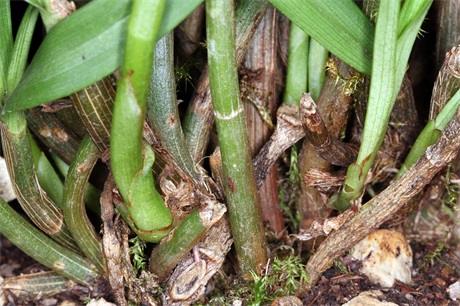反苞毛兰(西藏植物志)
Eria excavata Lindl., Gen. Sp. Orch. Pl. : 67. 1830: Hook., Icon. Pl. 19: t. 1846. 1889; King et Pantl. in Ann. Bot. Gard. Calcutta 8: 124. pl. 171. 1898; Kraenzl. in Engler, Pflanzenr. 50 (IV. 50, II. B. 21): 66. fig. 14F, H. 1911; 西藏植物志 5: 803. 1987. ——E. alba auct. non Lindl. : 西藏植物志5: 803. 图437: 1-2. 1987.
Broad-leaved forests along valleys; 1700-2100 m. S and SE Xizang [Bhutan, NE India, Nepal].Type specimens from Nepal.
This is difficult to distinguish from Eria alba Lindl.in morphological characteristics and was once considered by King & Pantling ( 1898 ) to be a self-fertilization type of E.alba. According to Hooker, Kraenzlin et al., both species have appendages in the lateral lobes of the labial lobes. The difference between the two species is that the former has obvious inward-curved pistils, while the latter is not obvious. The base of the former labial lobe does not shrink into claws, while the base of the latter labial lobe has a more obvious claw. According to the above characteristics, we consider that the specimens from Bomi ( Tongmai ) should belong to Eria excarvata rather than E. alba recorded in Flora Tibetica. In addition, although we have not seen flowers in the specimens of camphor wood in Tibet, they seem to belong to this species in terms of body shape and fruit morphology. In the ' Flora of Tibet ', it is also mentioned that this species is also distributed in Jiangxi, Yunnan and other places, but from a specimen we have seen in Jiangxi, it is obviously not within the scope of this species. |
| |
Pseudobulbs borne ca. 1 cm apart from each other, cylindric, ca. 3 cm, consisting of 1 distinct internode, sheathing at base, apex 4- or 5-leaved. |
| |
Leaf blade elliptic-oblanceolate, 16-18 × 2-3.4 cm, base contracted into petiole, apex acute. |
| |
Inflorescence arising from leaf axil, erect, 15-18 cm, reddish brown pubescent, sparsely few flowered; floral bracts lanceolate, 7-8 mm, abaxially brown pubescent, apex acuminate. Flowers white; pedicel and ovary 7-8 mm, brown pubescent; sepals and petals brown pubescent abaxially. Dorsal sepal subelliptic, ca. 9 × 3 mm, acute; lateral sepals falcate-lanceolate, ca. 9 × 4 mm, acute. Petals elliptic, ca. 6 × 2 mm, acute; lip suborbicular, nearly 5 mm, concave at base, 3-lobed from near base; lateral lobes ovate-triangular, small, obtuse, each with an erect callus adaxially; mid-lobe subreniform, ca. 4 × 5 mm, apex emarginate, warty-rugulose, with variable calli, usually 2-callose basally, sometimes with 5 flabellate, lamellate or thickened veins from base; central one extending to apex forming an apiculum. Column ca. 1 mm; foot incurved. Capsule cylindric, 1-1.5 cm. Fl. Jun. |
| |
| ||
| ||
|
| |







